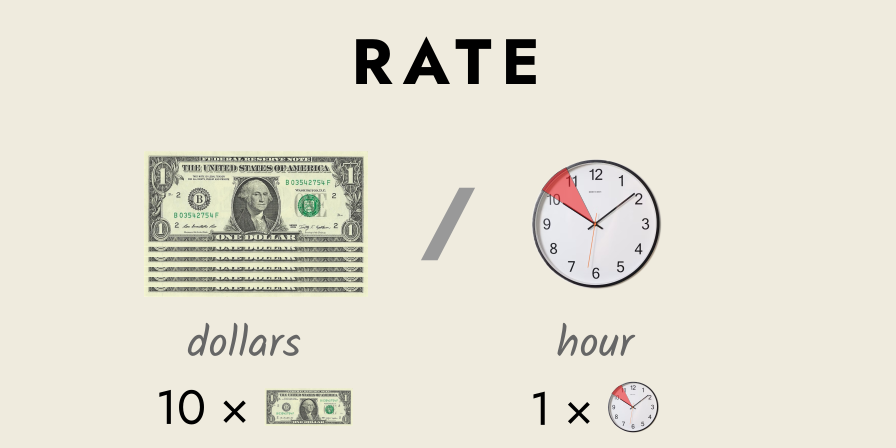
Rate
A rate is a comparison between two quantities of a different type (rather than of the same type).
The things being compared are called the “terms” of the rate.
For example:
- A count of dollars paid per hour worked. The first term is a multitude (a “count”), and the other a magnitude (“time”).
- A distance traveled in a period of time. Both terms are magnitudes, but they are of a different type (“distance” versus “time”).
Rates can be written in the standard ratio form of “𝑎 : 𝑏 ”, for the two quantities (“terms”) being compared, but this form is not commonly used.
Why?
Because rates involve different quantities, and it is essential not to confuse them with ratios.
Instead, rates are usually written using the forward slash, ∕, to separate the terms, with their units clearly specified e.g. $10∕ hour.
Rates are read aloud using the preposition “per”, e.g. $10/ hour is read as “10 dollars per hour”, where “per” just means “for each”.
Why Rates Matter
Many important things in life are rates.
How much you are paid for your labor, either as:
- a wage, given as an amount of money per hour, e.g. $10 per hour.
- a salary, which is a fixed rate of money per time period (generally a year), e.g. $60,000 per annum.
Speed is another rate: the amount of distance in a time period. The time period varies, depending on what we are measuring, for example:
- for cars, kilometers (km) or miles (mi) per hour (h) is typical, e.g. 60 km/h.
- for bullets, their speed is usually given in metres (m) or feet (ft) per second (s) and is called “muzzle velocity”, e.g. 375 m/s.
Incidence is another rate: the number of new cases of a disease (in a population) in a period of time.
For chronic conditions, like cancer, we normally assess new cases over a year.
But, when it comes to infectious diseases during a pandemic, we might use a shorter time period, such as weeks or months—even days, if it makes for a good headline!
